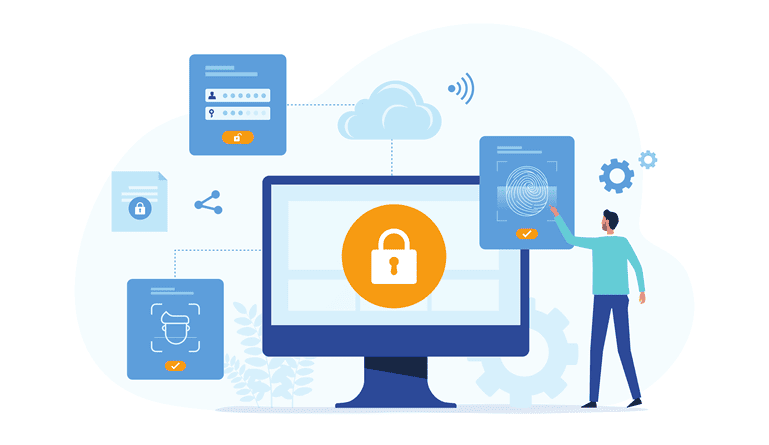Infrastructure as a Service or IaaS is a form of cloud computing that delivers essential resources to consumers on a subscription basis. These fundamentals include computation, network management, and storage needs and they are delivered through an on-demand digital-based service.
IaaS allows users to grow and diminish the size of these resources in order to deliver their product or service out to companies of all sizes that require it. In comparison to other systems, such as Platform as a Service (PaaS) and Software as a Service (SaaS), Infrastructure as a Service provides the least significant amount of control for resources in a cloud-based digital system.
How Does Infrastructure as a Service Work?
The infrastructure itself is a virtual system that includes many other services within it. Typically this includes structures such as data centers, servers, storage, networking, IP addresses, billing services, and other important business tools.
Users will be able to download these systems, implement them into their business model as well as introduce these services to any of their clients.
Who Uses IaaS?
Many types and industries of companies use Infrastructure as a Service. There are also many Cloud Computing Companies that stem from larger companies. Some of these are Digital Ocean, IBM Cloud, Amazon AWS (Amazon Web Services), Microsoft Azure, OpenStack, Rackspace, VMware, and Red Hat.
Many startup companies use IaaS to manage their resources and tools to help organize them when they are getting their feet off the ground. This creates the perfect market for IaaS developers to seek out businesses that need a start to manage their resources as well as larger companies that have scaled up so high that they require a better grip on the control of their tools for their employee size.
IaaS Platform and Architecture
-
Physical Data Centers
IaaS provides data center services that are typically located all over the world. They contain physical machines that help contain information all over the internet. In most models, end-users don’t’ need to interact directly with the physical infrastructure, so this service is done for them.
-
Compute
By being virtually computed tools, IaaS is essentially a large virtual machine that helps manage resources. Typically companies that are smaller don’t have the capacity to do this on their own and larger companies already use their space for other information, therefore both sizes need another entity to help balance out the outsourcing of information and tools. This helps balance the load and responsibilities for companies of any size.
-
Network
This refers to the cloud resourcing and management that IaaS provides. Physical space is an important real estate for companies, so storing information, tools, and resources in a network is important, and being able to provide this helps companies structure their businesses accordingly.
-
Storage
The main components of IaaS storage services include block, file, and object. Storing information in block and file typically refers to traditional data centers. The difference is moving these to a cloud-based format. Object storage is the most common storage mode, where cloud storage is distributed and accessed over HTTP, and the scale doesn’t necessarily matter in terms of performance. This means units of all sizes and all companies can benefit from this service.
Implementation of Infrastructure as a Service
To implement IaaS into a system, it’s important to determine how necessary it is for a business.
It’s important to look at how much storage a company needs. When looking at cloud computing providers, it’s important to see if storage needs are important and how much of that is necessary for a company.
It’s also important to look at all agreements when looking into an IaaS. By adding a third party partner to a business, it adds another dynamic that is important to make sure the security of the company is up to date. By looking into all potential business risks, will help keep security and safety for the company sharp.
When adding more cloud-based services into a company, it’s important to look into the skills of one’s own IT team. If a business’ IT team is capable of handling this workload, it may be more beneficial to work in-house rather than through an outside IaaS. If the IT isn’t well equipped, sourcing outside will help ease their workflow and budget.
Most Common Use Cases for IaaS Solutions
-
Test and Development
Using IaaS solutions helps companies develop ways to test and develop their scalability by allocating resources to another place. This can help companies scale up or down depending on the amount of testing done.
-
Website Hosting
IaaS is the perfect way for companies to host complicated web projects such as website hosting. By using a cloud-hosted website, companies can profit since IaaS will help take over the responsibilities of networks and cloud services.
-
Storage, Backup, and Recovery
For some companies, managing storage, backup and recovery isn’t ideal and could be too much work for their teams. IaaS helps take this burden off the company to help them focus on other business aspects.
-
Web Apps
Web applications other than websites can be hosted on the cloud and can help companies offload work to another service while upkeep other resources.
-
High-Performance Computing
Being able to give responsibilities that require high-level computing to another service can help free up time and service to the company to help it scale.
-
Big Data Analysis
Similar to high-performance computing, being able to obtain data at scale can help increase performance and efficiency for a company.
Benefits of Infrastructure as a Service
Deployment
Being able to deploy such a service helps determine the trending trajectory of a company and seeing if it’s worth it to scale and see areas of improvement for the business.
Scalability
A huge benefit to IaaS, taking different resources and tools and working with them efficiently can help scale a larger company by spreading out assets and help smaller companies by giving them a reliable service to be backed upon.
( Also Read: Benefits of Infrastructure as a Service (IAAS) )
Difference Between IaaS, SaaS, and PaaS
| IaaS | PaaS | SaaS |
|---|---|---|
| Datacenter with a physical building | Datacenter with a physical building | Datacenter with a physical building |
| Security firewalls for networks | Security firewalls for networks | Security firewalls for networks |
| Storage and servers | Storage and servers | Storage and servers |
| Operating Systems | Operating Systems | |
| Business analytics, management for databases, tools for development | Business analytics, management for databases, tools for development | |
| Locally hosted applications |









